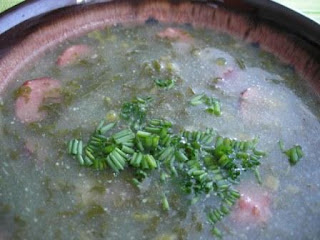Soup triggers a lot of emotions in many. Some just love soups and would eat some soup every day. Others occasionally have soup as a light meal. Then there are those who consider soup as non-food and avoid eating it as much as possible. Some treat soup as something served in a soup kitchen. Some Moms want their children to eat soup as soup is healthy.
Personally, I tend to prefer soups that have pieces in them to purée-soups. Maybe because I like to eat the soup rather than “drink” it.
I was fascinated to read that there was a soup festival, a Soup Congress, in a small Portuguese town earlier this year where restaurants served some 50 different soups. How cool is that!!
I don’t have any scientific evidence but I do believe that soup is healthy, good for digestion, warms the body, and usually involves one or more vegetables. Chicken soup is good against common cold and so on.
A little thing that I don’t like so much is that some soups turn into a colour that is somewhere between dull greenish brown, despite being absolutely tasty. Then, some fresh green parsley or chives or a little cream or some fried bacon can pimp it up to please the eye as much as the taste buds.
 |
| Green and Purple Kale and Cavalo Nero (Tuscan black cabbage) |
October - November is the peak season for various cabbage soups and here is one from Portugal. The popular “caldo verde” or green broth, made with potato, couve de gallega or kale and sausage. I have used leafy curly kale cabbage, but if that is not available, collard greens or Savoy cabbage will also do. Caldo verde is perfect since it is both puréed and has some pieces in it at the same time.
 |
| Curly Kale |
 |
| Kale cabbage |
Caldo Verde Recipe
Serves 4
2 l water
1-1.5kg potatoes
1 onion
500g of green (leafy) cabbage, kale
200-300g Portuguese linguiça, chorizo or other sausage
Salt
(bay leaf)
Heat the water in a large pot. Peel and cut the potatoes into cubes and boil.
Add chopped onion, some salt and optionally a bay leaf and cook until potato is soft. Remove the bay leaf. Purée the mix into smooth soup.
Separate the kale-cabbage leaves from the core and cut into very thin strips. Add the kale into the soup and cook at medium heat till cabbage is soft for ca 10 min.
Cut the sausage into slices and add to the soup. Simmer a few minutes together with the cabbage.
Choose the spicy sausage or spice up the soup with a bit of chilli powder when using mild sausages.
Some recipes advise to cook the kale separately; however I prefer that everything from the cabbage stays in the soup.
Serve hot.
Bom apetite!























